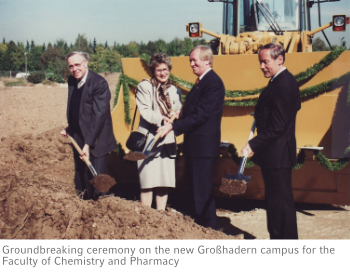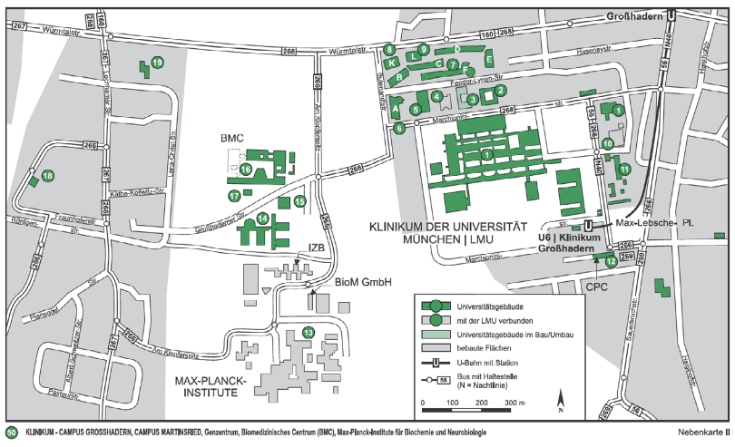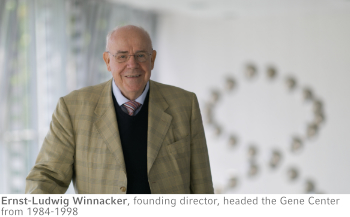1984 - 1998: Ernst-Ludwig Winnacker - part II
Challenging start for the Gene Center Munich
In the following, Ernst-Ludwig Winnacker discusses two topics that cost him a lot of time in the early days of the Gene Center: the construction of the building in Großhadern/Martinsried and the controversies surrounding genetic engineering.
Construction of the Gene Center building
 One of the stipulations of the approval notice from the Federal Ministry for Education and Research (BMBF) for the Munich Gene Center was the construction of a corresponding laboratory building. Initially, the plan was to build this down-town on the site of the old Türkenkaserne barracks. But then, in 1991, a U-turn was decided upon by the state ministry. For one thing, the Gene Center proved to be far too complex for a building in the City center. And because it was not just about the Gene Center alone, but also about a new building for the entire Faculty of Chemistry and Pharmacy, it was decided to erect both new buildings in the immediate vicinity of the Großhadern University Hospital, with the Gene Center as the first construction phase. The associated competition was won in 1987 by the architects Werz, Ottow, Bachmann and Marx, who were awarded the planning contract in 1991, now for the site in Großhadern. The old building site in the city center was reserved for the “Pinakothek der Moderne”. This created a real museum hub in the city center, which subsequently became a major tourist attraction.
One of the stipulations of the approval notice from the Federal Ministry for Education and Research (BMBF) for the Munich Gene Center was the construction of a corresponding laboratory building. Initially, the plan was to build this down-town on the site of the old Türkenkaserne barracks. But then, in 1991, a U-turn was decided upon by the state ministry. For one thing, the Gene Center proved to be far too complex for a building in the City center. And because it was not just about the Gene Center alone, but also about a new building for the entire Faculty of Chemistry and Pharmacy, it was decided to erect both new buildings in the immediate vicinity of the Großhadern University Hospital, with the Gene Center as the first construction phase. The associated competition was won in 1987 by the architects Werz, Ottow, Bachmann and Marx, who were awarded the planning contract in 1991, now for the site in Großhadern. The old building site in the city center was reserved for the “Pinakothek der Moderne”. This created a real museum hub in the city center, which subsequently became a major tourist attraction.
Construction progress: adherence to budget and deadline
The Gene Center had to be built quickly, as time had already been lost due to the reclassifications. Ministerial Director Dr. Hans Zimmermann, as Head of the University Department in the Bavarian Ministery of Research, came up with a remarkable idea. Every other Monday, he invited all those involved and responsible to a meeting at the LMU Rectorate: the University President Steinmann, the head of the government of Upper Bavaria, the head of the University Building Office, the architects, the Heads of the Munich fire and fire safety departments and others who were jointly responsible for the construction and who could make decisions on the spot without having to make further inquiries. Miraculously, everyone was somehow pulling in the same direction. In this way, it was not only possible to meet or even beat the construction deadline, but also the budget of 84 million DM. I myself was one of the members of the aforementioned group, so I was always up to date. With these kind of arrangements, construction progress was extremely rapid. There were rarely any delays. Our building took 30 months to be completed, exactly as foreseen. Where else can you find something like this these days?
Political dimensions of genetic engineering research
One of the structural challenges were the genetic engineering safety levels. These had been prescribed for buildings of this type with the passing of the Genetic Engineering Act on July 1, 1990. This (federal) law was based on the recommendation of a commission of inquiry of the German Bundestag on the subject of "Opportunities and Risks of Genetic Engineering", which met between the summer of 1984 and January 1987. It recommended, among other things, a legal regulation of genetic engineering. This took quite a while to organize and, eventually, to be made into law. As a member of this Commission, I voted in favor of this kind of regulation although I was aware of the fact that in the US genetic engineering regulation was only subject to guidelines, under the auspices of the National Institutes of Health, and not to constitutional amendments. I felt at the time, that due to the severity of the discussion around recombinant DNA work in Germany, an arrangement with only guidelines would have exacerbated the discussion.
Personal thread
My membership of this Enquete Commission, as well as my lecturing and speaking activities, exposed me to the public. As a result, I ended up on a "hit list" of the Red Army Faction in 1987, on which around 30 people were listed who were to be incapacitated with knee shots. Between 1987 and 1990, I was therefore temporarily driven to the Cene Center in Martinsried under police protection. My office in the new Gene Center building was given bullet-proof windows, and our private home in Munich-Nymphenburg was secured with bars. Over time, the security measures were relaxed. However, they have not been completely lifted to this day.
Security precautions in the building: bulletproof glass and secured entrances
The discussion about the opportunities and risks of genetic engineering also influenced the construction of the Gene Center, not only because of the installation of bullet-proof windows in my later office on the 4th floor of the building, but also because of the necessity for public hearings, for example in the district committee (Bezirksausschuß) of Grosshadern. I appeared there twice in the spring of 1989 to answer questions from the public. It was my personal policy from the outset to discuss this issue as openly as possible. Thereby citizens' fears were addressed at an early stage, not only at these town-hall hearings, but also on many other occasions, such as in parishes and at party conferences. Thus, during the construction phase of the Gene Center, but also later on, there were never any protests or other difficulties in this regard.
Efforts to achieve a balanced discussion of this topic and strong concerns about weakening Germany as a location for innovation led to the first amendment of the original law as early as 1993 and thus to a fundamental simplification of the handling of genetic engineering, at least in laboratories. However, certain reservations remain to this day, particularly with regard to food. The label "GMO-free" or "Without Genetic Engineering" serves the purpose of transparency on the one hand, which I can and do accept. But on the other hand it leads to negative connotations and wide-spread concerns for the entire field and its industrial applications. The rapid developments of mRNA derived vaccines in the years 2020 and 2021 were impressive. There is hope that with the advent of CRISPR-Cas technologies, European guidelines will soon be adapted to permit limited applications of recombinant DNA technologies in certain crop plants.
Construction of the Gene Center building was only the beginning. In the meantime, buildings for the faculties of Chemistry and Pharmacy, of Biology and of Medicine followed suit resulting in an entirely new campus structure. This arrangement has created critical mass. It favors interdisciplinarity and cluster developments and thus became a major European hub for the transfer of Know-how from basic research into industrial applications (see below map of LMU-Campus Großhadern/Martinsried).



